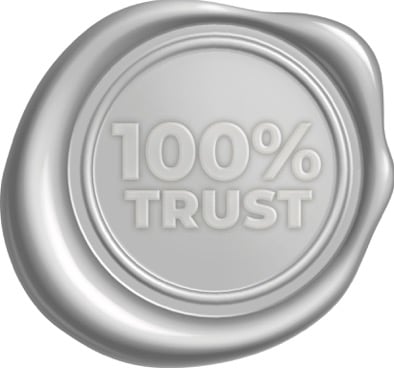Chapter 5: Website Trust Signals— Making Visitors Feel at Home
(Following is Chapter 5 of Trust Signals: Brand Building in a Post-Truth World.)
Few things are...

(Following is Chapter 4 of Trust Signals: Brand Building in a Post-Truth World.)
Signed, sealed, and delivered. Seal of approval.
Sealed their fate.
Seal the deal.
Sealed with a kiss.
My lips are sealed.
These popular idioms derive from a common origin: the design stamped on wax known as a “seal” in English usage, beginning in the Middle Ages.
When you consider the wax seal today, you may think of decorative attachments to wedding invitations or special gifts. But the wax seal has borne far greater responsibility over the course of its fascinating one-thousand-plus-year history.
Wax seals have lessons to teach about trust, the importance of its tangible symbols, and their enduring role in business and in life. As you’ll learn in this chapter, there is a direct through line from the sealed writs of Medieval kings to the trust seals that began appearing on ecommerce websites in the late 1990s—and that are a pervasive online presence today.
KING JOHN’S LASTING CONTRIBUTION TO TRUST
In the thousand-year history of the British monarchy there is only one King John; he ruled from 1199 to 1216. The name was spoiled for future kings by John’s reputation for being both cruel and cowardly—a combination that earned him the nickname “Softsword.”
But one contribution of King John has endured—the impression of his seal in beeswax to arm one of the most important documents in Western history, the Magna Carta.
In the Middle Ages, wax seals came into common use among royals, bishops, and government officials to authenticate official documents. By the latter part of the thirteenth century, all levels of European society—from patricians to peasants—were using seals, both for business purposes and personal messages.
Over time, wax seals came to forge powerful associations with many aspects of trust, assuring privacy, security, legitimacy, endorsement, and status.
FIVE ASSURANCES DELIVERED BY WAX SEALS
Let’s take a closer look at these five assurances:
#1: Privacy
When an envelope was sealed by wax, whether bearing a message of business or romance, it communicated that it was meant for the recipient’s eyes only.
#2: Security
In addition to conveying that a message was private, the wax seal served as a practical method of security, indicating the missive had not been seen by others. A broken seal meant broken trust.
#3: Legitimacy
Legitimacy is validity as determined by the government or other authorizing organization. Wax seals stamped by such organizations established legitimacy.
#4: Endorsement
A step above legitimacy is endorsement, when a seal explicitly conveys approval or support. King John’s seal on the Magna Carta established his endorsement of the agreement.
#5: Status
Powerful people typically pressed wax seals with a specially made signet ring, a symbol of status. High-ranking members of the church or government might require a visitor to kiss their signet to show their allegiance. When the signet’s owner died, the ring would be destroyed to prevent forgeries.
FAST-FORWARD TO TRUST SEALS

Fast-forward to the present day and you’ll find the more things change, the more they stay the same. In the internet age, trust seals —a direct descendant of the wax seal in etymology as well as meaning—have come to fill a key role in establishing trust in online commerce.
A trust seal can be defined as any emblem, badge, symbol, or icon intended to quickly establish trust with prospective customers and other audiences online.
In the early days of internet commerce, retailers realized that many consumers were skeptical of making purchases or sharing their credit card information. Trust seals helped to reassure customers and remove friction from the buying process.
As the Journal of Computer-Mediated Communication put it in March 2000:
Developing trust between suppliers and consumers is critical for the continued growth of Internet commerce...By using Trusted Third Parties (TTPs) and privacy statements, Internet retailers can help assuage some of consumers’ concerns about the Internet. (Palmer, Bailey, and Faraj)
The TTPs were represented by seals from organizations such as the Better Business Bureau and TRUSTe, which emerged as the first widely used trust badges in the late 1990s.
The use and variety of trust seals on the web have expanded dramatically over the past two decades. To this day, research shows that trust seals on ecommerce sites can cut cart abandonment in half.
And such badges aren’t just for online merchants anymore. Any brand can benefit from the instant social proof that trust seals can provide.
In ecommerce, trust seals are most visible during the checkout process, but many sites today use them on their home page, product pages, and About Us pages as well.
Let’s take a closer look at the original trust badges—the Better Business Bureau and TRUSTe seals—which are still alive and kicking today.
The Better Business Bureau Seal
The Better Business Bureau (BBB) has been a symbol of trust not only since the early days of ecommerce, but dating back to the era of teletypes and horses and buggies.
In 1912, the organization emerged to help businesses respond to a crisis in public trust, when exaggerated advertising claims were the subject of high-profile lawsuits by the US government against the Coca-Cola Company and others.
More than a century later, the BBB is still relevant. Whereas retail storefronts in the pre-internet world proudly displayed the BBB logo in their shop windows, today about four hundred thousand accredited businesses worldwide display the trust seal on their websites.
Beyond those accredited companies, more than 6.2 million businesses have profiles at BBB.org, which receives 220 million website visits annually (BBB Serving the Heart of Texas 2021; Better Business Bureau, n.d.). Visitors use the site to search for local businesses (roofers, car mechanics, HVAC repair, insurance agents) as well as to post reviews and lodge complaints. The BBB warns the public when a company receives a lot of complaints, or when it gets wind of various scams online or in local communities.
![]()
SIDEBAR: IS A BBB SEAL WORTH THE COST?
Given the organization’s storied history and high visibility, you might assume that adding a BBB seal to your website would be a no-brainer. The catch is that to display the seal you have to be accredited—and that costs money. Depending on the nature of the accreditation and the size of your business, the cost typically runs between a few hundred and several thousand dollars per year.
So, is it worth it? You can find any number of articles online by those who say it isn’t, based on their own experiences. In my research, I’ve found that the BBB accreditation remains a good value, particularly for the following types of businesses:
Adding a trust badge to your site touting that you are a BBB-accredited company with an A+ rating carries a lot of weight to this day—which is why you should consider it for your business, whether or not you are an online merchant.
![]()
The TRUSTe Seal
At the ripe old age of twenty-five, the TRUSTe seal is the grand-daddy of trustmarks. Founded as a nonprofit association, TRUSTe promoted online commerce by helping businesses self-regulate privacy concerns—long before the EU’s General Data Protection Regulation (GDPR), the California Consumer Privacy Act (CCPA), and other data privacy regulations.
TRUSTe was a trailblazer from the start. Among its achievements, in 2000 it became the first organization to form a framework encompassing US and European privacy standards. While the company has since rebranded as TrustArc and is now a for-profit business, it maintains the TRUSTe certification program and the mission to help websites earn the trust of their visitors.
As important as privacy was to skeptical consumers in the internet’s early days, it’s fair to say that issues like how to balance privacy and personalization are even more hotly contested today, with the biggest tech companies in the world on the hot seat. That puts TRUSTe—which offers certifications to demonstrate compliance with GDPR, CCPA, and other regulations and protections— right where the action is.
THE PROLIFERATION OF WEBSITE TRUST SEALS
With the early success of the BBB and TRUSTe seals in increasing ecommerce conversions, many other certifying organizations have emerged over the years with their own seals, badges, and emblems for display on ecommerce and other websites.
In addition to these seals, online merchants often create their own badges to showcase specific promises to their customers, such as money-back guarantees and hassle-free returns.
Today, website trust badges fall into five primary categories:
#1: Security Trust Badges
A “safe checkout” badge indicates that an ecommerce site’s check-out process is secure and that customer financial data is protected. The Norton seal is among the most popular trustmarks on the Internet, viewed approximately one hundred million times per day by consumers in 170 countries. The TrustedSite, PayPal, and Shopify seals also communicate trust and security. Brands often display these trust badges near their “Add to Cart” links for maximum impact.
#2: Payment Trust Badges
Consumers are more likely to trust your ecommerce website if you accept widely used forms of payment such as Visa, Mastercard, American Express, PayPal, or Apple Pay. Merchant programs by Visa and others also protect consumers against fraud, making these trust badges even more reassuring to visitors.
#3: Guarantee Trust Badges
Adding a “30-Day Money-Back Guarantee” or “Free 1-Year Warranty” badge to your site can significantly increase sales by reducing your customer’s perceived risk. Standing by your product with a guarantee or warranty also communicates your belief in the product’s quality. Merchants typically display this badge prominently on their sites, such as near the checkout button.
#4: Shipping Trust Badges
Offering free shipping and hassle-free returns is another effective way to earn buyer trust. Amazon Prime made free shipping something that many consumers now take for granted. Following suit can greatly reduce shopping cart abandonment.
#5: Endorsement Trust Badges
People trust what other people say about you more than what you say about yourself. That is the power of third-party validation for brands. Brands can showcase third-party endorsements in myriad ways, from a BBB seal to customer logos, media coverage, and industry awards. Endorsement trust badges are a great visual shortcut to quickly convey your brand’s strengths, competencies, and achievements.
THE ETERNAL NEED FOR TRUST SIGNALS
Earlier in this chapter, I noted that wax seals engendered trust in five ways, including:
Think about the website trust seals you come across today. How do they work to gain your trust?
The TRUSTe seal ensures your privacy.
The Norton and TrustedSite seals provide security.
The Better Business Bureau seal guarantees legitimacy.
Customer logos offer endorsement.
Industry award badges convey status
So you can see that the more things change, the more they stay the same. We look for the same basic types of assurance in building trust today that we did one thousand years ago.
While today you might only come across an actual wax seal on a wedding invitation or other ceremonial document, know that their legacy lives on whenever you go online.

Scott is founder and CEO of Idea Grove, one of the most forward-looking public relations agencies in the United States. Idea Grove focuses on helping technology companies reach media and buyers, with clients ranging from venture-backed startups to Fortune 100 companies.

(Following is Chapter 5 of Trust Signals: Brand Building in a Post-Truth World.)
Few things are...

(Following is Chapter 1 of Trust Signals: Brand Building in Post-Truth World.)
I hadn’t heard from...
Leave a Comment